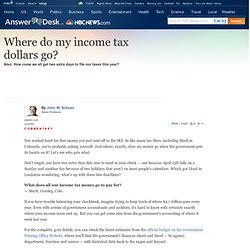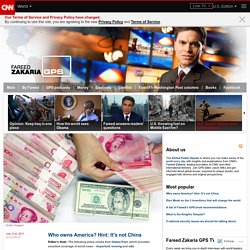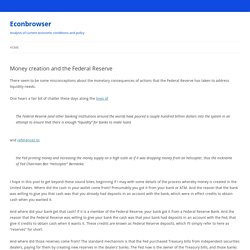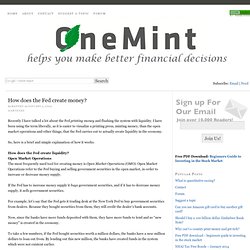

Where do my income tax dollars go? - Business - Answer Desk. You worked hard for that money you just sent off to the IRS.

So like many tax filers, including Mark in Colorado, you're probably asking yourself: Just where, exactly, does my money go when the government gets its hands on it? Let's see who gets what. Don't forget, you have two extra days this year to send in your check — one because April 15th falls on a Sunday and another day because of two holidays that aren't on most people's calendars. Which got Lloyd in Louisiana wondering: what's up with these late deadlines? What does all our income tax money go to pay for? If you have trouble balancing your checkbook, imagine trying to keep track of where $2.7 trillion goes every year.
Speech, Bernanke. Since World War II, inflation--the apparently inexorable rise in the prices of goods and services--has been the bane of central bankers. Economists of various stripes have argued that inflation is the inevitable result of (pick your favorite) the abandonment of metallic monetary standards, a lack of fiscal discipline, shocks to the price of oil and other commodities, struggles over the distribution of income, excessive money creation, self-confirming inflation expectations, an "inflation bias" in the policies of central banks, and still others.
Despite widespread "inflation pessimism," however, during the 1980s and 1990s most industrial-country central banks were able to cage, if not entirely tame, the inflation dragon. With inflation rates now quite low in the United States, however, some have expressed concern that we may soon face a new problem--the danger of deflation, or falling prices. So, is deflation a threat to the economic health of the United States? Who owns America? Hint: It's not China. Editor's Note: The following piece comes from Global Post, which provides excellent coverage of world news – important, moving and odd.

By Tom Mucha, Global Post Truth is elusive. But it's a good thing we have math. Our friends at Business Insider know this, and put those two principles to work today in this excellent and highly informative little slideshow, made even more timely by the ongoing talks in Washington, D.C. aimed at staving off a U.S. debt default. Here's the big idea: Many people — politicians and pundits alike — prattle on that China and, to a lesser extent Japan, own most of America's $14.3 trillion in government debt. But there's one little problem with that conventional wisdom: it's just not true. Here's a quick and fascinating breakdown by total amount held and percentage of total U.S. debt, according to Business Insider: So America owes foreigners about $4.5 trillion in debt.
Does the Fed Create Money? Does the federal reserve make money? Why ZIRP doesn’t work. Bill Gross has a wonky column in the FT, saying that setting interest rates at zero doesn’t boost economic growth: With policy rates at or approaching zero yields and QE facing political limits in almost all developed economies, it is appropriate to question not only the effectiveness of historical conceptual models but entertain the possibility that they may, counterintuitively, be hazardous to an economy’s health. Certainly the record will show that countries with persistently low interest rates tend to have sluggish growth, and although the obvious causality there runs the other way — central banks cut rates in response to slow growth — it’s never been clearer than it is now that such policies don’t always work.
Gross’s point is that zero rates, far from encouraging people to borrow more, actually encourage deleveraging instead, at both the short and the long end of the curve. Why wouldn’t people want to borrow at ultra-low interest rates? Money creation and the Federal Reserve. There seem to be some misconceptions about the monetary consequences of actions that the Federal Reserve has taken to address liquidity needs.

One hears a fair bit of chatter these days along the lines of The Federal Reserve (and other banking institutions around the world) have poured a couple hundred billion dollars into the system in an attempt to ensure that there is enough “liquidity” for banks to make loans and references to the Fed printing money and increasing the money supply on a high scale as if it was dropping money from an helicopter, thus the nickname of Fed Chairman Ben “Helicopter” Bernanke. I hope in this post to get beyond these sound bites, beginning if I may with some details of the process whereby money is created in the United States.
And where did your bank get that cash? And where did those reserves come from? How does the Fed create money? Recently I have talked a lot about the Fed printing money and flushing the system with liquidity.

I have been using the term liberally, as it is easier to visualize a printing press, minting money, than the open market operations and other things, that the Fed carries out to actually create liquidity in the economy. So, here is a brief and simple explanation of how it works. How does the Fed create liquidity? Open Market Operations The most frequently used tool for creating money is Open Market Operations (OMO).